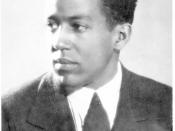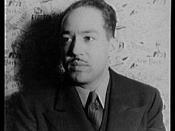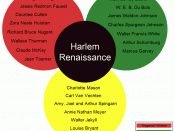Harlem Renaissance
Between 1919 and 1926, large numbers of black Americans left their rural southern states homes to move to urban centers. This black urban migration combined with experimental trends and rise of a group of radical black intellectuals all contributed to the particular styles and unexpected success of black artists. What began as a series of literary discussions in Manhattan was first known as the "New Negro Movement," but was then called the Harlem Renaissance. This movement brought new creative activity and gave the African-Americans a chance of recognition from whites in expressing themselves and their heritage through writing, art, and music.
The African-Americans expressed their creativity and thoughts through writing. Some of the major writers through the time period of the Harlem Renaissance were Claude McKay, Countee Cullen, and Langston Hughes. These artists and many more through this period of time expressed themselves through personal and political experiences throughout there live through poetry, prose, plays, and novels.
They wrote of such topics from lynching to dancing. This period expresses the first time period in which white people started to read and listen to what the African-Americans had to say.
The African-Americans were very originative in there works of art. Three of the key artists of the Harlem Renaissance were Loïs Mailou Jones, William H. Johnson, and Palmer Hayden. These artists have so many different ways of expressing their feelings. William H. Johnson did this mostly by painting people in chain gangs, and blacks before the "New Negro Movement." On the other hand Palmer Hayden expressed himself by showing the good times of the Renaissance, and black historical events in his paintings. Not just blacks, but whites participated in the art part of the Harlem Renaissance also. Whites were found both in the night life...


